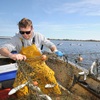The Exmouth Gulf prawn fishery has recently entered an assessment against the MSC standard for sustainable fishing. I recently took the opportunity to spend some time at sea with research staff from the Department of Fisheries and the crew of the fishing vessel Point Cloates K to see how industry and science collaboration can help contribute to the better understanding of a fishery from both a sustainability and an economic perspective.
Being a relative newcomer to Western Australia but not to the fishing industry, I knew that the best way to truly understand a fishery was to immerse yourself in it. And when the opportunity came up to spend a few nights at sea as part of the research trip for the Exmouth Gulf prawn fishery, I dusted off my oilskins and prepared myself for a few sleepless nights aboard the fishing vessel Point Cloates K .
The shallow, sandy and muddy habitats of the Exmouth Gulf are the perfect habitat for the highly productive prawn species. Being most active at night when safer from predators including species such as shark and octopus, this is the best time for the crew of the Point Cloates K to get a bumper catch of prawns. This does in turn lead to some unsociable working hours for the Exmouth fishers, a negative which is offset by the financial incentive for all the late nights. The prawn fisheries in Exmouth Gulf and Shark Bay are considered to be the third most valuable in the state with an annual value of $40-$50 million. Working from sunset to sunrise around the lunar cycle, the skipper Lenny and his crew of three work under a starry sky to sort, cook and package the prawns to offer a high quality product for markets around Australia as well as further afield to the likes of Japan and Hong Kong.
The target species for the Exmouth fishery are tiger prawns (Penaeus esculentus), king prawns (Penaeus latisulcatus) and endeavour prawns (Metapenaeus endeavouri). The Department of Fisheries (DoF) research staff who were on board for this trip were interested in seeing the size, sex and maturity of the highly prized tiger prawns ensuring that the fishing effort wasn’t adversely affecting the reproductive capacity of the stock. Surveying the fishery on a regular basis over the seven month season gives the DoF a good indication of current fishing trends and can allow for a management response to take into account any fluctuations in catch rates. In return, industry also sees how the science and research feeds into management of the fishery. Whilst on board the fishing vessel, the DoF Research Officer seems happy to discuss the science, research and management of the fishery with the skipper and crew leading to an encouragingly positive collaboration between science and industry.
Selectivity
Working with selective fishing gear, the Exmouth Gulf prawn fishery has made significant environmental gains since the fishery started in the early 1960’s. The use of bycatch reduction devices (BRD’s) ensures that the larger, unwanted catch including turtles, fish and sponges are not caught in this fishery. There is the added benefit to the fishermen that this selective fishing method also helps reduce fuel costs and leads to a higher quality catch of prawns. With a cleaner catch, less time is spent sorting through the catch and may offer the crew a quick 30 minute nap in between hauls… much needed when you consider the 12-14 hour overnight shift for the skipper and crew!
For the small amount of unwanted catch which is caught alongside the prawns, the boat is designed to get any bycatch back in the water as quickly as possible. The boats working in the Exmouth Gulf all have hoppers equipped with flowing sea-water which holds the catch until it is sorted. This allows for any catch which has no commercial value to be returned to the sea in the best condition possible, as well as ensuring the retained catch is of the highest possible quality. Impacts of a fishery on bycatch is something which will have to be considered under an MSC assessment to ensure that the fishery does not adversely affect any of these species.
MSC Process
The Exmouth Gulf prawn fishery alongside the Shark Bay prawn fishery have recently entered MSC assessment to demonstrate that they are fishing sustainably and this is measured against an independent standard. Over the next year, the assessment team will look at the fishery operation, gather information from stakeholders and review the current management approach before the fishery could possibly achieve MSC certification. However, the measures taken by this fishery including regular research trips, using selective gear including the use of bycatch reduction devices and flexible management plans will all feed into this assessment process. If you wish to be involved in the assessment process for this fishery, have a quick read of my recent blog on stakeholder engagement throughout an MSC assessment.
Markets
The research undertaken by the Department of Fisheries helps to maintain a healthy prawn population and can take into account any environmental fluctuations including the impacts of passing cyclones on the state of the prawn fishery. With a strong domestic market for prawns in Australia, especially prawns at Christmas, this strong research and management approach is good news for you when it comes to lighting up the BBQ with your prawn skewers in hand or when you next fancy cooking a prawn risotto.
As I returned back to Exmouth following my short time at sea, I leave a little more enlightened on the Exmouth prawn fishery, a bit more desperate for a night in a bed which is not a two foot wide bunk and a lot more respectful of the crew and their attempts to mitigate their impacts on the wider marine environment.
Matt, MSC Australia Fisheries Outreach Officer



